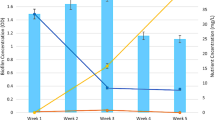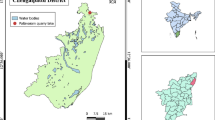Abstract
The role of chemical interactions in shaping microbial communities has raised increasing interest over the last decade. Many benthic microorganisms are known to develop chemical strategies to overcome competitors, but the real importance of chemical interactions within freshwater biofilm remains unknown. This study focused on the biological and chemical mechanisms of an interaction involving two benthic microorganisms, an allelopathic filamentous green alga, Uronema confervicolum, and a common diatom, Fistulifera saprophila. Our results showed that functions critical for benthic phototrophic microorganisms were inhibited by U. confervicolum extracts. Growth, cell motility, adhesion, and photosynthetic activity were impaired at extract concentrations ranging between 5 and 20 μg ml−1. The adhesion inhibition was mediated by intracellular nitric oxide (NO) induction. A bioassay-guided fractionation of the extract with HPLC helped to identify two C18 fatty acids present in the growth-inhibiting fractions: linoleic (LA) and α-linolenic (LNA) acids. These compounds represented 77 % of the total free fatty acids of U. confervicolum and were present in the culture medium (1.45 μg l−1 in total). Both could inhibit the diatom growth at concentrations higher than 0.25 μg ml−1, but had no effect on cell adhesion. The discrepancy between the effective concentrations of fatty acids and the concentration found in culture medium may be explained by the presence of high-concentration microenvironments. The compounds involved in adhesion inhibition remain to be identified. Though further experiments with complex biofilms are needed, our results suggest that U. confervicolum may participate to the control of biofilm composition by inhibiting diatom adhesion.




Similar content being viewed by others
References
Biggs BJF (1996) Patterns in benthic algae of streams. In: Stevenson R, Bothwell M, Lowe R (eds) Algal ecology: freshwater benthic ecosystems. Academic, San Diego, pp 31–56
Bravi E, Perreti G, Montanari L (2006) Fatty acids by high performance liquid chromatography and evaporative light-scattering detector. J Chromatogr A 1134:210–214
Byers JA (1992) Optimal fractionation and bioassay plans for isolation of synergistic chemicals—the subtractive–combination method. J Chem Ecol 18:1603–1621. doi:10.1007/bf00993233
Chiang I-Z, Huang W-Y, Wu J-T (2004) Allelochemicals of Botryococcus braunii (Chlorophyceae). J Phycol 40:474–480
del Rio LA, Corpas FJ, Barroso JB (2004) Nitric oxide and nitric oxide synthase activity in plants. Phytochemistry 65:783–792
DellaGreca M, Zarrelli A, Fergola P, Cerasuolo M, Pollio A, Pinto G (2010) Fatty acids released by Chlorella vulgaris and their role in interference with Pseudokirchneriella subcapitata: experiments and modelling. J Chem Ecol 36:339–349. doi:10.1007/s10886-010-9753-y
Dodds WK (1991) Community interactions between the filamentous alga Cladophora glomerata (L) Kuetzing, its epiphytes, and epiphytes grazers. Oecologia 85:572–580. doi:10.1007/bf00323770
Dondajewska R, Budzynska A (2009) The influence of filamentous green algae on chlorococcal algae (Desmodesmus spp.). Oceanol Hydrobiol Stud 38:21–25
Einhellig FA (2004) Mode of allelochemical action of phenolic compounds. In: Macias FA, Galindo JCG, Molinillo JMG, Cutler HG (eds) Allelopathy—chemistry and mode of action of allelochemicals. CRC Press, London, pp 217–238
Genty B, Briantais JM, Baker NR (1989) The relationship between the quantum yield of photosynthetic electron-transport and quenching of chlorophyll fluorescence. Biochim Biophys Acta 990:87–92
Gross EM (2003) Allelopathy of aquatic autotrophs. Crit Rev Plant Sci 22:313–339
Hagmann L, Jüttner F (1996) Fischerellin A, a novel photosystem-II-inhibiting allelochemical of the cyanobacterium Fischerella muscicola with antifungal and herbicidal activity. Tetrahedron Lett 37:6529–6542
Hirata K, Yoshitomi S, Dwi S, Iwabe O, Mahakhant A, Polchai J, Miyamoto K (2003) Bioactivities of nostocine A produced by a freshwater cyanobacterium Nostoc spongiaeforme TISTR 8169. J Biosci Bioeng 95:512–517
Ianora A et al (2006) New trends in marine chemical ecology. Estuar Coasts 29:531–551
Ikawa M (2004) Algal polyunsaturated fatty acids and effects on plankton ecology and other organisms. UNH Cent Freshwat Biol Res 6:17–44
Juneau P, El Berdey A, Popovic R (2002) PAM fluorometry in the determination of the sensitivity of Chlorella vulgaris, Selenastrum capricornutum, and Chlamydomonas reinhardtii to copper. Arch Environ Contam Toxicol 42:155–164
Jüttner F (1999) Allelochemical control of natural photoautotrophic biofilms. In: Keevil CW, Godfree A, Holt D, Dow C (eds) Biofilms in aquatic environment. Royal Society of Chemistry, Cambridge, pp 43–50
Jüttner F, Wu J-T (2000) Evidence of allelochemical activity in subtropical cyanobacterial biofilms of Taiwan. Arch Hydrobiol 147:505–517
Kamenarska ZG, Dimitrova-Konaklieva SD, Nikolova C, Kujumgiev AI, Stefanov KL, Popov SS (2000) Volatile components of the freshwater algae Spirogyra and Mougeotia. Z Naturforsch (C) 55:495–499
Keating KI (1977) Allelopathic influence on blue-green bloom sequence in a eutrophic lake. Science 196:885–887
Kilham SS, Kreeger DA, Lynn SG, Goulden CE, Herrera L (1998) COMBO: a defined freshwater culture medium for algae and zooplankton. Hydrobiologia 377:147–159. doi:10.1023/a:1003231628456
Lang IK, Hodac L, Friedl T, Feussner I (2011) Fatty acid profiles and their distribution patterns in microalgae: a comprehensive analysis of more than 2000 strains from the SAG culture collection. BMC Plant Biol 11. doi:10.1186/1471-2229-11-124
Leflaive J, Ten-Hage L (2007) Algal and cyanobacterial secondary metabolites in freshwaters: a comparison of allelopathic compounds and toxins. Freshwat Biol 52:199–214
Leflaive J, Ten-Hage L (2009) Allelopathic interactions in benthic biofilms: effects of abiotic conditions on production of and sensitivity to allelochemicals. J N Am Benthol Soc 28:271–280
Leflaive J, Ten-Hage L (2011) Effects of 2E,4E-decadienal on motility and aggregation of diatoms and on biofilm formation. Microb Ecol 61:363–373
Leflaive J, Boulêtreau S, Buffan-Dubau E, Ten-Hage L (2008a) Temporal patterns in epilithic biofilms—relation with a putative allelopathic activity. Fundam Appl Limnol 173:121–134
Leflaive J, Buffan-Dubau E, Ten-Hage L (2008b) Algal bioactive compounds reduce net oxygen fluxes of artificial diatom biofilms. Aquat Microb Ecol 51:276–284
Leflaive J, Nicaise Y, Lacroix G, Ten-Hage L (2008c) Colony induction and growth inhibition in Desmodesmus quadrispina (Chlorococcales) by allelochemicals released from the filamentous alga Uronema confervicolum (Ulotrichales). Environ Microbiol 10:1536–1546
Lillington JM, Trafford DJH, Makin HLJ (1981) A rapid and simple method for the esterification of fatty acids and steroid carboxylic acids prior to gas liquid chromatography. Clin Chim Acta 111:91–98. doi:10.1016/0009-8981(81)90425-3
Lock MA (1993) Attached microbial communities in rivers. In: Ford TE (ed) Aquatic microbiology—an ecological approach. Blackwell Scientific Publications, Oxford, pp 113–138
Lürling M, Van Donk E (2000) Grazer-induced colony formation in Scenedesmus: are there costs to being colonial ? Oikos 88:111–118
Pohnert G, Steinke M, Tollrian R (2007) Chemical cues, defence metabolites and the shaping of pelagic interspecific interactions. Trends Ecol Evol 22:198–204
Pouvreau JB, Housson E, Le Tallec L, Morancais M, Rince Y, Fleurence J, Pondaven P (2007) Growth inhibition of several marine diatom species induced by the shading effect and allelopathic activity of marennine, a blue-green polyphenolic pigment of the diatom Haslea ostrearia (Gaillon/Bory) Simonsen. J Exp Mar Biol Ecol 352:212–225. doi:10.1016/j.jembe.2007.07.011
Pratt R et al (1944) Chlorellin an antibacterial substance from Chlorella. Science 99:351–352. doi:10.1126/science.99.2574.351
Ramanathan KR (1964) Ulotrichales. Indian Council for Agricultural Research, New Delhi
Reigosa MJ, Sanchez-Moreiras A, Gonzales L (1999) Ecophysiological approach in allelopathy. Crit Rev Plant Sci 18:577–608
Reinikainen M, Meriluoto JAO, Spoof L, Harada K-I (2001) The toxicities of a polyunsaturated fatty acid and a microcystin to Daphnia magna. Environ Toxicol 16:444–448
Rice EL (1984) Allelopathy, 2nd edn. Academic, New York
Roháček K, Barták M (1999) Technique of the modulated chlorophyll fluorescence: basic concepts, useful parameters, and some applications. Photosynthetica 37:339–363. doi:10.1023/A:1007172424619
Schmitt-Jansen M, Altenburger R (2008) Community-level microalgal toxicity assessment by multiwavelength-excitation PAM fluorometry. Aquat Toxicol 86:49–58
Scutt JE (1964) Autoinhibitor production by Chlorella vulgaris. Am J Bot 51:581. doi:10.2307/2439983
Sterner RW (1989) Resource competition during seasonal succession toward dominance by cyanobacteria. Ecology 70:229–245
Takamo K, Igarashi S, Mikami H, Hino S (2003) Causation of reversal simultaneity for diatom biomass and density of Phormidium tenue during the warm season in eutrophic Lake Barato, Japan. Limnology 4:73–78
Tetu SG et al (2013) Impact of DNA damaging agents on genome-wide transcriptional profiles in two marine Synechococcus species. Front Microbiol 4. doi:10.3389/fmicb.2013.00232
Thompson SEM, Taylor AR, Brownlee C, Callow ME, Callow GA (2008) The role of nitric oxide in diatom adhesion in relation to substratum properties. J Phycol 44:967–976
Underwood GJC, Paterson DM (2003) The importance of extracellular carbohydrate production by marine epipelic diatoms. Adv Bot Res 40:183–240
Vanelslander B et al (2012) Daily bursts of biogenic cyanogen bromide (BrCN) control biofilm formation around a marine benthic diatom. Proc Natl Acad Sci U S A 109:2412–2417. doi:10.1073/pnas.1108062109
Vardi A, Schatz D, Beeri K, Motro U, Sukenik A, Levine A, Kaplan A (2002) Dinoflagellate-cyanobacterium communication may determine the composition of phytoplankton assemblage in a mesotrophic lake. Curr Biol 12:1767–1772
Vardi A, Formiggini F, Casotti R, De Martino A, Ribalet F, Miralto A, Bowler C (2006) A stress surveillance system based on calcium and nitric oxide in marine diatoms. PLoS Biol 4:411–419
Vardi A et al (2008) A diatom gene regulating nitric-oxide signaling and susceptibility to diatom-derived aldehydes. Curr Biol 18:895–899
Vreeland V, Waite JH, Epstein L (1998) Polyphenols and oxidases in substratum adhesion by marine algae and mussels. J Phycol 34:1–8
Watson SB (2003) Cyanobacterial and eukaryotic algal odour compounds: signal or by-products? A review of their biological activity. Phycologia 42:332–350
Wendehenne D, Durner J, Klessig DF (2004) Nitric oxide: a new player in plant signalling and defence responses. Curr Opin Plant Biol 7:449–455. doi:10.1016/j.pbi.2004.04.002
Wetherbee R, Lind JL, Burke J, Quatrano RS (1998) The first kiss: establishment and control of initial adhesion by raphid diatoms. J Phycol 34:9–15
Wu J-T, Chiang IR, Huang WY, Jane WN (2006) Cytotoxic effects of free fatty acids on phytoplankton algae and cyanobacteria. Aquat Toxicol 80:338–345
Yamada N, Murakami N, Morimoto T, Sakakibara J (1993) Auto-growth inhibitory substance from the freshwater cyanobacterium Phormidium tenue. Chem Pharm Bull 41:1863–1865
Acknowledgments
This work was supported by the MicroBien EC2CO program to JL. We are grateful to S. Alessi for her help during experiments and to F. Gilbert for material support. We thank C. Zedde for technical assistance on autopurification system provided and on Acquity UPLC-PDA-ELSD provided by the Institute of Toulouse (ICT-FR CNRS 2599). Lipidomic analyses were performed on the Toulouse INSERM Metatoul-Lipidomique Core Facility-MetaboHub ANR-11-INBS.
Author information
Authors and Affiliations
Corresponding author
Additional information
Responsible editor: Philippe Garrigues
Electronic supplementary material
Below is the link to the electronic supplementary material.
ESM 1
(DOCX 285 kb)
Rights and permissions
About this article
Cite this article
Allen, J.L., Ten-Hage, L. & Leflaive, J. Impairment of benthic diatom adhesion and photosynthetic activity by allelopathic compounds from a green alga: involvement of free fatty acids?. Environ Sci Pollut Res 22, 13669–13680 (2015). https://doi.org/10.1007/s11356-014-3873-9
Received:
Accepted:
Published:
Issue Date:
DOI: https://doi.org/10.1007/s11356-014-3873-9




